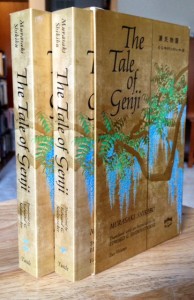 Today marks the first day of Year Two of my three-year exploration of the world’s greatest creative achievements.
Today marks the first day of Year Two of my three-year exploration of the world’s greatest creative achievements.
I begin Year Two by reading the two-volume edition of The Tale of Genji, which was written in the early part of the 11th century.
According to its entry on Wikipedia:
The Tale of Genji is a classic work of Japanese literature written by the noblewoman and lady-in-waiting Murasaki Shikibu in the early years of the 11th century, around the peak of the Heian period. It’s sometimes called the world’s first novel, the first modern novel, the first psychological novel or the first novel still to be considered a classic. Notably, the novel also illustrates a unique depiction of the livelihoods of high courtiers during the Heian period. While universally considered a masterpiece, its precise classification and influence in both Western and Eastern canon has been a matter of debate.
The first partial translation of Genji Monogatari into English was by Suematsu Kenchō, published in 1882. Arthur Waley published a six-volume translation of all but one chapter, with the first volume published in 1921 and the last in 1933. In 1976, Edward Seidensticker published the first complete translation into English, made using a self-consciously “stricter” approach with regards to content if not form. The most recent English translation was published in 2001 by Royall Tyler and aims at fidelity in content and form to the original text.
The edition I bought is the Edward Seidensticker translation. I Googled The Tale of Genji and, from what I read, it seemed a lot of people thought the Edward Seidensticker edition was the best one. Granted, “best” – when it comes to translations – is in the eye of the beholder. It’s not likely a translation of any kind will Continue reading
